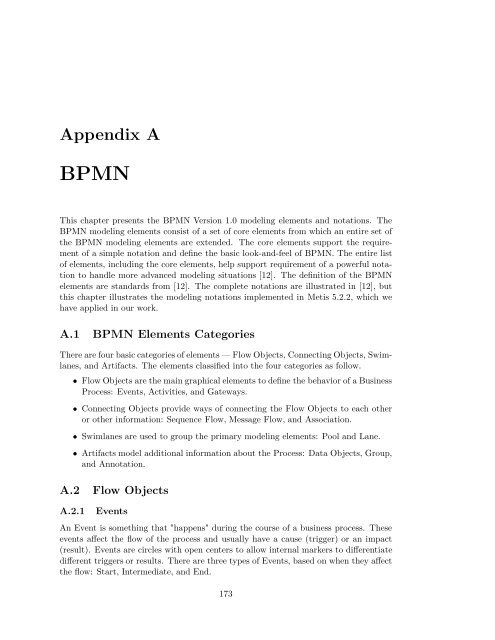Semantic Annotation for Process Models: - Department of Computer ...
Semantic Annotation for Process Models: - Department of Computer ...
Semantic Annotation for Process Models: - Department of Computer ...
Create successful ePaper yourself
Turn your PDF publications into a flip-book with our unique Google optimized e-Paper software.
Appendix A<br />
BPMN<br />
This chapter presents the BPMN Version 1.0 modeling elements and notations. The<br />
BPMN modeling elements consist <strong>of</strong> a set <strong>of</strong> core elements from which an entire set <strong>of</strong><br />
the BPMN modeling elements are extended. The core elements support the requirement<br />
<strong>of</strong> a simple notation and define the basic look-and-feel <strong>of</strong> BPMN. The entire list<br />
<strong>of</strong> elements, including the core elements, help support requirement <strong>of</strong> a powerful notation<br />
to handle more advanced modeling situations [12]. The definition <strong>of</strong> the BPMN<br />
elements are standards from [12]. The complete notations are illustrated in [12], but<br />
this chapter illustrates the modeling notations implemented in Metis 5.2.2, which we<br />
have applied in our work.<br />
A.1 BPMN Elements Categories<br />
There are four basic categories <strong>of</strong> elements — Flow Objects, Connecting Objects, Swimlanes,<br />
and Artifacts. The elements classified into the four categories as follow.<br />
• Flow Objects are the main graphical elements to define the behavior <strong>of</strong> a Business<br />
<strong>Process</strong>: Events, Activities, and Gateways.<br />
• Connecting Objects provide ways <strong>of</strong> connecting the Flow Objects to each other<br />
or other in<strong>for</strong>mation: Sequence Flow, Message Flow, and Association.<br />
• Swimlanes are used to group the primary modeling elements: Pool and Lane.<br />
• Artifacts model additional in<strong>for</strong>mation about the <strong>Process</strong>: Data Objects, Group,<br />
and <strong>Annotation</strong>.<br />
A.2 Flow Objects<br />
A.2.1<br />
Events<br />
An Event is something that "happens" during the course <strong>of</strong> a business process. These<br />
events affect the flow <strong>of</strong> the process and usually have a cause (trigger) or an impact<br />
(result). Events are circles with open centers to allow internal markers to differentiate<br />
different triggers or results. There are three types <strong>of</strong> Events, based on when they affect<br />
the flow: Start, Intermediate, and End.<br />
173
















